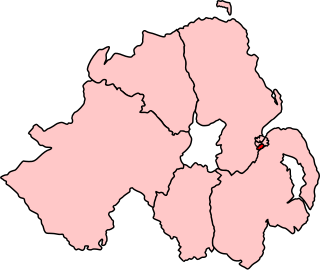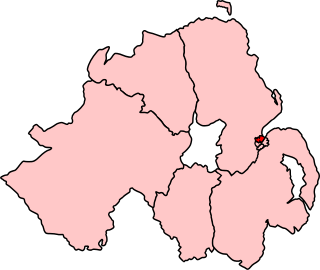Queen's University of Belfast was a university constituency represented in the House of Commons of the United Kingdom Parliament from 1918 until 1950.
There were two elections in Ireland on 24 May 1921, as a result of the Government of Ireland Act 1920 to establish the House of Commons of Northern Ireland and the House of Commons of Southern Ireland. A resolution of Dáil Éireann on 10 May 1921 held that these elections were to be regarded as elections to Dáil Éireann and that all those returned at these elections be regarded as members of Dáil Éireann. According to this theory of Irish republicanism, these elections provided the membership of the Second Dáil. The Second Dáil lasted 297 days.
North Kilkenny was a parliamentary constituency in Ireland, represented in the House of Commons of the Parliament of the United Kingdom. It returned one Member of Parliament (MP) from 1885 to 1922.
Cromac, a division of Belfast, was a UK parliamentary constituency in Ireland. It returned one Member of Parliament (MP) to the House of Commons of the United Kingdom from 1918 to 1922, using the first past the post electoral system.
Duncairn, a division of Belfast, was a UK parliamentary constituency in Ireland. It returned one Member of Parliament (MP) to the House of Commons of the United Kingdom from 1918 to 1922, using the first past the post electoral system.
Falls, a division of Belfast, was a UK parliamentary constituency in Ireland. It returned one Member of Parliament (MP) to the House of Commons of the United Kingdom from 1918 to 1922, using the first past the post electoral system.
Ormeau, a division of Belfast, was a UK parliamentary constituency in Ireland. It returned one Member of Parliament (MP) to the House of Commons of the United Kingdom from 1918 to 1922, using the first past the post electoral system.
Pottinger, a division of Belfast, was a UK parliamentary constituency in Ireland. It returned one Member of Parliament (MP) to the House of Commons of the United Kingdom from 1918 to 1922, using the first past the post electoral system.
Shankill, a division of Belfast, was a UK parliamentary constituency in Northern Ireland. It returned one Member of Parliament (MP) to the House of Commons of the United Kingdom from 1918 to 1922, using the first past the post electoral system.
St Anne's, a division of Belfast, was a UK parliamentary constituency in Ireland. It returned one Member of Parliament (MP) to the House of Commons of the United Kingdom from 1918 to 1922, using the first past the post electoral system.
Victoria, a division of Belfast, was a UK parliamentary constituency in Ireland. It returned one Member of Parliament (MP) to the House of Commons of the United Kingdom from 1918 to 1922, using the first past the post electoral system.
Woodvale, a division of Belfast, was a UK parliamentary constituency in Ireland. It returned one Member of Parliament (MP) to the House of Commons of the United Kingdom from 1918 to 1922, using the first past the post electoral system.
Mid Down was a UK parliamentary constituency in Ireland. It returned one Member of Parliament (MP) to the British House of Commons from 1918 to 1922, using the first past the post electoral system.
National University of Ireland (NUI) is a university constituency in Ireland, which currently elects three senators to Seanad Éireann. Its electorate is the graduates of the university, which has a number of constituent universities. It previously elected members to the House of Commons of the United Kingdom (1918–21), to the House of Commons of Southern Ireland (1921) and to Dáil Éireann (1918–1936).
The Government of Ireland Act 1920 was an Act passed by the Parliament of the United Kingdom to create two separate parliaments in Ireland: the Parliament of Northern Ireland and the Parliament of Southern Ireland. The Fifth Schedule to this act provided the constituencies for the House of Commons in these two separate parliaments. These same constituencies also replaced those provided in the Redistribution of Seats (Ireland) Act 1918 for representation of Ireland in the House of Commons of the United Kingdom at Westminster. Sinn Féin used these constituencies to elect the Second Dáil (1921–22) and those constituencies in Southern Ireland were used to elect the Third Dáil (1922–23).

Belfast West was a borough constituency of the Parliament of Northern Ireland from 1921 to 1929. It returned four MPs, using proportional representation by means of the single transferable vote.

Belfast South was a borough constituency of the Parliament of Northern Ireland from 1921 to 1929. It returned four MPs, using proportional representation by means of the single transferable vote.

Belfast East was a borough constituency of the Parliament of Northern Ireland from 1921 to 1929. It returned four MPs, using proportional representation by means of the single transferable vote.
The Anglo-Irish Treaty was signed in London on 6 December 1921 and Dáil Éireann voted to approve the treaty on 7 January 1922, following a debate through late December 1921 and into January 1922. The vote was 64 in favour, 57 against, with the Ceann Comhairle and 3 others not voting. The Sinn Féin party split into opposing sides in the aftermath of the Treaty vote, which led to the Irish Civil War from June 1922 to May 1923.

Belfast North was a borough constituency of the Parliament of Northern Ireland from 1921 to 1929. It returned four MPs, using proportional representation by means of the single transferable vote.




